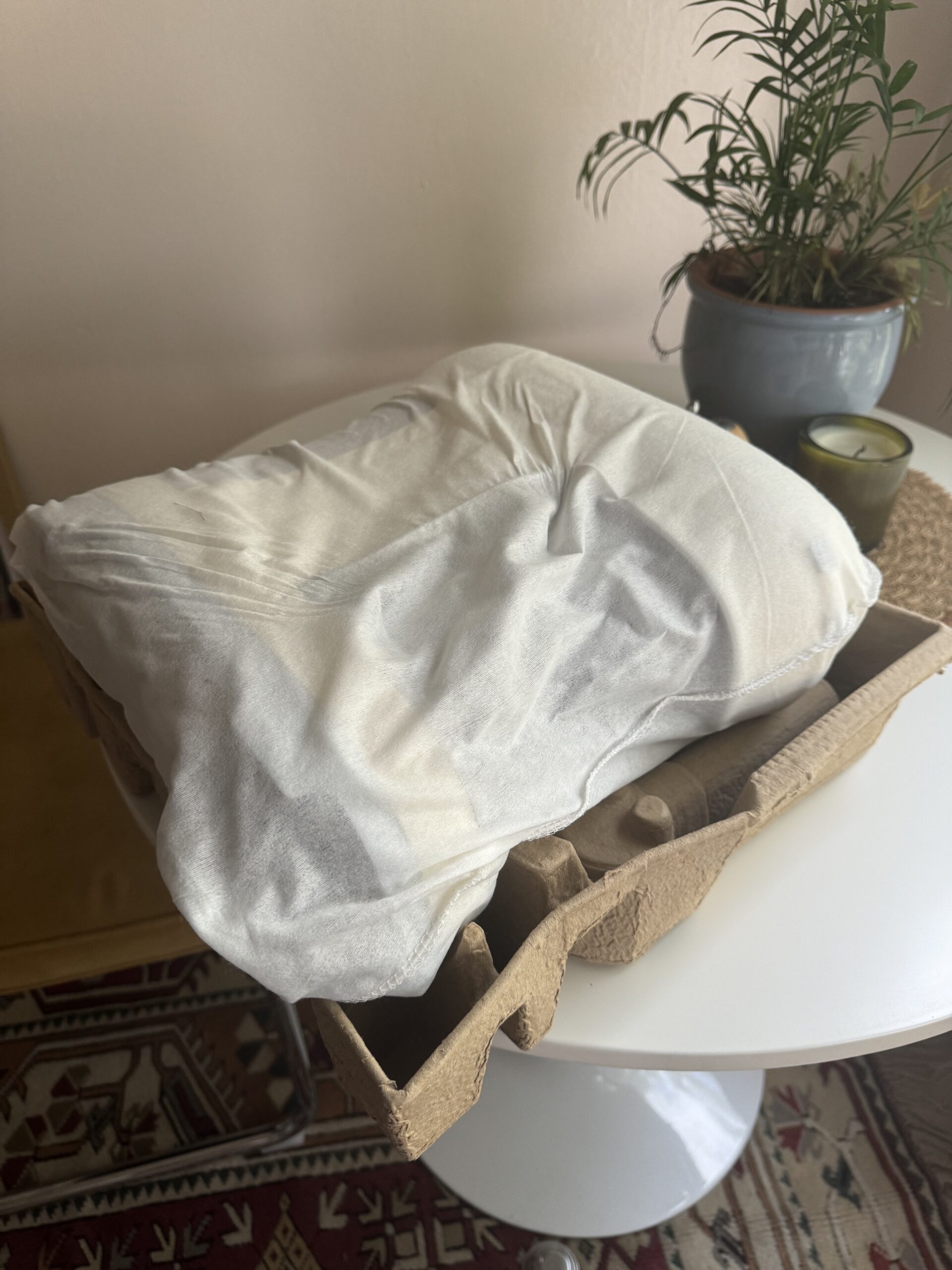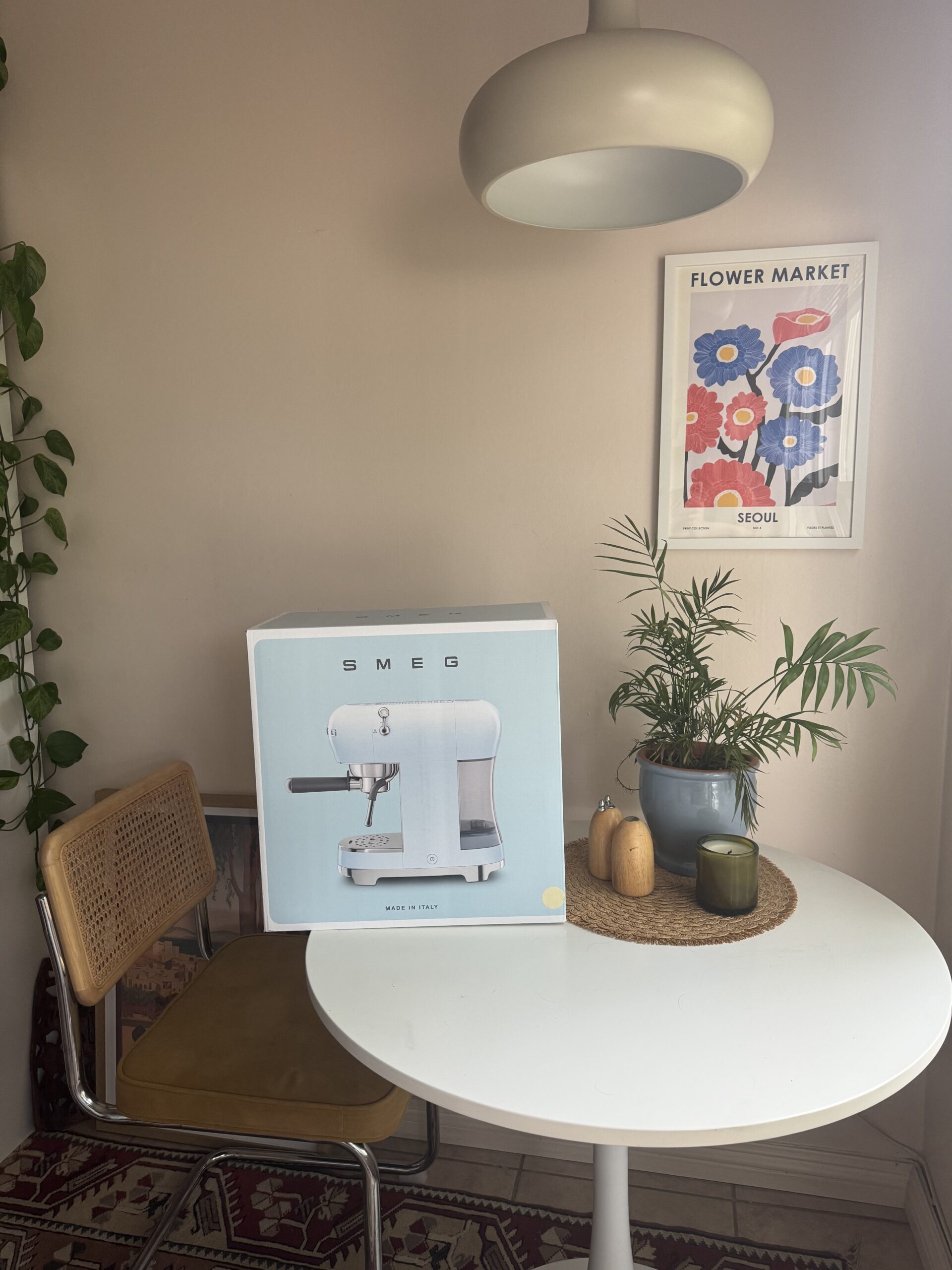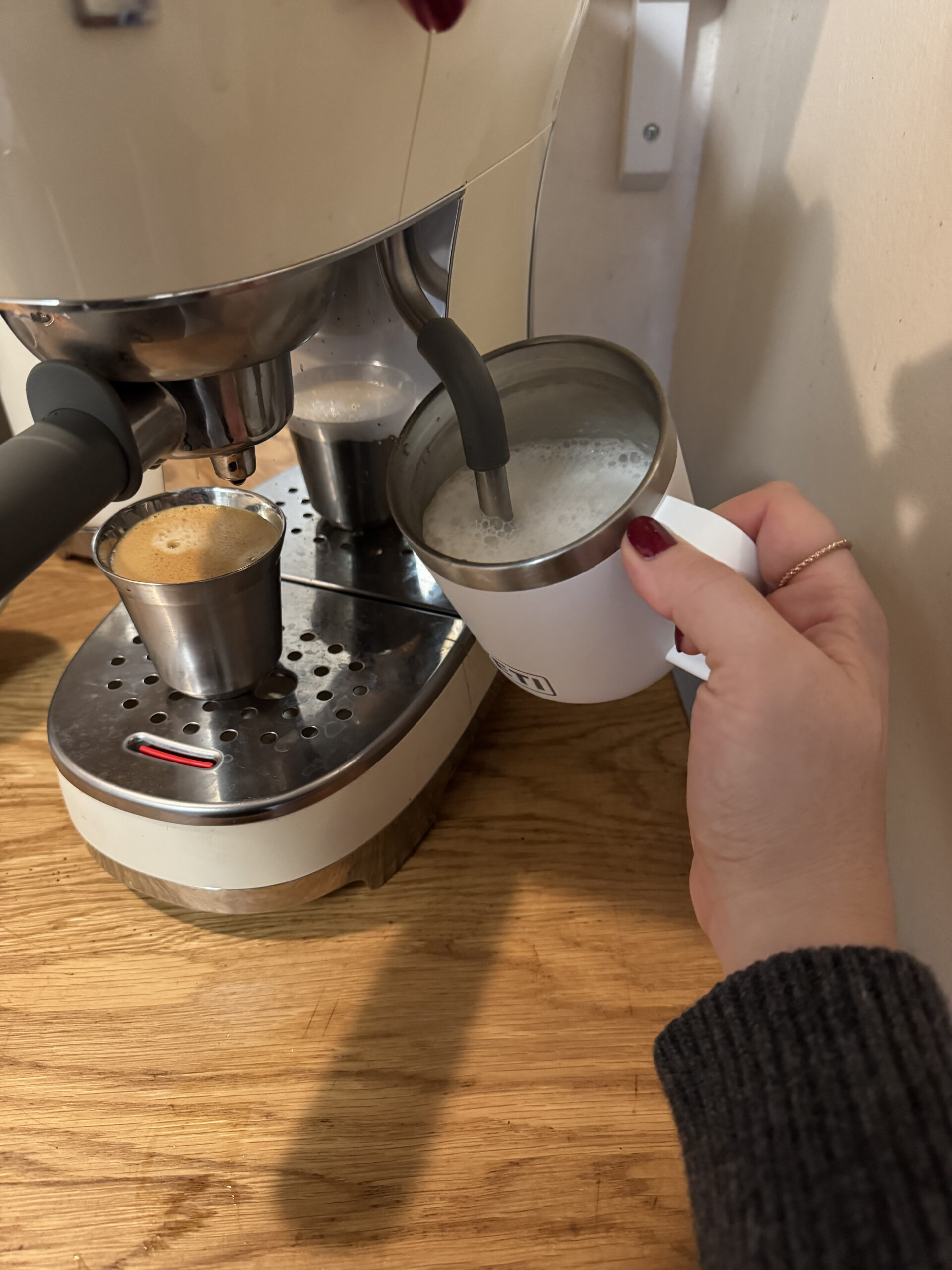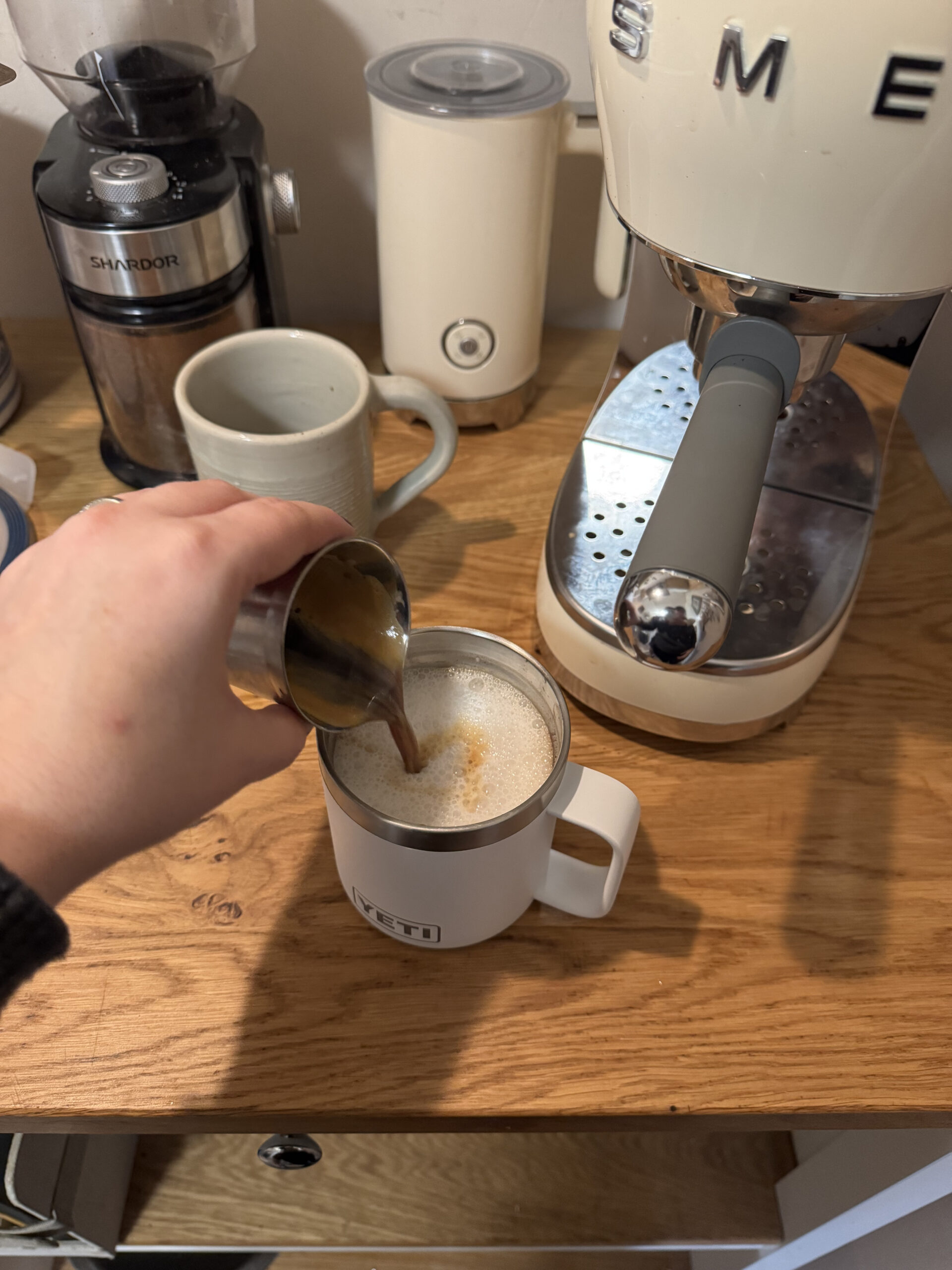Summary: To help cut down on my coffee shop budget (and the waste created from to-go cups!), I decided to try the Smeg Espresso machine for at-home lattes and espresso drinks. While a bit of an investment, I have already saved so much money and time by making coffee at home.
Pros
- The Smeg Espresso Machine is a perfect entry-level espresso machine for small spaces and those looking to learn the art of latte-making at home.
- Smeg is a family-owned company that has been creating high-quality appliances since 1948, so you can trust the quality and craftsmanship of these small but mighty machines.
- The machine is incredibly user-friendly and has an easy-to-follow user manual — it’s ready to use from the box.
- While pricey, it’s more affordable than some top-of-the-line espresso machines, making it a good option for getting started.
Cons
- Some expert baristas note this isn’t the best quality espresso machine on the market. If you’re looking to invest in something that you can use for decades, there are more advanced espresso machines out there.
- The initial investment can feel a bit steep at $600. The machine doesn’t have everything you need for a latte (e.g., a milk frothing cup or espresso grinder).
I have a confession: My coffee shop spending has gotten a bit out of hand this past year. Even though I no longer commute to an office, I find myself craving a latte mid-afternoon around the time when I need some sunshine and a desk break. And while I could make a refill of coffee at home, it’s so much easier (and more fun!) to get out of the house for 20 minutes and visit my favorite baristas for an afternoon treat.
As you can imagine, this hasn’t been kind to my budget. Coffee in California (specifically Los Angeles) is expensive — like $7–$8 before tip. When added up, if I’m averaging a handful of lattes a week, I can spend anywhere from $100-$150+ a month just on coffee. Yikes.
“When added up, if I’m averaging a handful of lattes a week, I can spend anywhere from $100-$150+ a month just on coffee. Yikes.”
This coffee habit isn’t super friendly to the environment, either. Though I could bring my own mug (and I try to remember!), billions of disposable coffee cups are discarded each year, creating a mounting environmental challenge. These seemingly harmless cups often have a plastic lining, making them nearly impossible to recycle. According to one study, it’s estimated that the market size for single-use hot paper coffee cups will reach 294 billion units by 2025. Most end up in landfills or as pollution, affecting ecosystems and contributing to the broader waste crisis. That’s… not great.
All this to say, I’ve known for a while that I should take my dollars and invest in an at-home coffee setup instead. With so many espresso machines on the market, though, I wanted to find one that could fit my small space, make a great cup of coffee, and be easy to use (I’m not a great barista). Enter Smeg.
Smeg: An Italian, family-owned brand known for its craftsmanship
Smeg is a family-owned company that has been creating high-quality appliances since 1948, blending timeless Italian craftsmanship with a distinctive retro aesthetic. Based in Northern Italy, the brand is known for turning everyday kitchen essentials into design statements (we’ve all seen the brand’s cute refrigerators), seamlessly marrying form and function.
“Smeg is a family-owned company that has been creating high-quality appliances since 1948, blending timeless Italian craftsmanship with a distinctive retro aesthetic.”
What sets Smeg apart is its commitment to sustainability and thoughtful manufacturing — prioritizing energy efficiency and durability so its products last for years. Whether it’s the bold-colored fridge or a sleek espresso machine, every Smeg piece is crafted with care.

I decided this specific espresso machine would be the perfect option for my “cut back on buy coffee” experiment. The smaller Smeg Espresso Machine is everything I love about thoughtful design—compact, efficient, and beautiful. From the moment I set it on my counter, it felt like I’d brought a little slice of an Italian café into my apartment. Even in my tiny kitchen, it fits perfectly on my countertop, proving you don’t need much space to enjoy barista-quality coffee at home.
“From the moment I set it on my counter, it felt like I’d brought a little slice of an Italian café into my apartment.”
As for specs, the small but mighty machine has a 15-bar pressure pump and a thermoblock heating system, ensuring rich, flavorful espresso. The adjustable frothing wand lets me whip up creamy cappuccinos or lattes whenever the mood strikes.
What I really love, though, is how Smeg encourages a more mindful coffee routine. Instead of relying on pods that end up in the trash, I can use freshly ground espresso. Plus, the removable 1-liter water tank and easy-to-clean drip tray make it as practical as it is stylish.
Unboxing the Restore & setting it up
If I had to select one word to describe the Smeg setup, it would be easy. This is truly a beginner barista’s dream machine, as it comes put together, and all you need to do is plug it in. Hard to beat that!
“If I had to select one word to describe the Smeg setup, it would be easy.“
In the box, you’ll find the espresso machine, a portafilter, a tamper, a water reservoir, and a drip tray. You’ll also get a user-friendly manual to guide you through the setup process. Simply plug in the machine, fill the water tank, and insert the portafilter. The clear instructions will walk you through everything from adjusting the grind to frothing milk. I had my little coffee bar set up in mere minutes!
There isn’t much more to share here other than I appreciated the thoughtful and sustainable packaging, too (a soft canvas bag for the machine, cardboard packaging, no plastic).


Making my first latte
Now for the real test — how was the coffee?
I should start by saying I was a barista for about five minutes in college. I worked at the on-campus coffee shop and quickly discovered how difficult it can be to make a quality latte (tip your baristas; it truly is an art!). I often burnt the milk or didn’t pull the shot just right, so I was a bit nervous about using the Smeg, even though the machine is much easier to use than commercial espresso machines.
“I recommend investing in a grinder specific to espresso beans.”
I started by filling the water reservoir and switching on the machine, giving it a moment to heat up. While warming, I used a coffee grinder to grind my espresso beans to a fine consistency. (Note: I recommend investing in a grinder specific to espresso beans — BFCM is a great time to snag one!)
Once the machine was ready, I tamped the ground coffee into the portafilter, making sure it was evenly pressed, and then locked the portafilter into place. If you need a visual for this, I found this video tutorial helpful. I then pressed the espresso button and watched as the shot began to brew.


Now, here’s the important part to make sure your latte tastes cafe-quality: while the espresso is brewing, you need to froth the milk. I poured my milk into a frothing jug (the machine doesn’t come with this, but you can pick one up secondhand or at most home stores), then placed it under the steam wand. Turning the steam dial, I lowered the wand just beneath the milk’s surface, letting the steam create a creamy, velvety foam. (Here’s another video tutorial. I find these to be so much more helpful). Once I heard the sound of the milk swirling and felt the jug warming up, I poured the frothed milk over my espresso. I then added a few sprinkles of vanilla spice for flavoring.
“Now, here’s the important part to make sure your latte tastes cafe-quality: while the espresso is brewing, you need to froth the milk.”
As for the taste test, the first latte was a 7/10. It wasn’t as creamy or rich as my favorite coffee shop, but I chalk that up to my inexperience. As I’ve continued using the machine and figuring out the best milk to use (I prefer either homemade oat milk or store-bought barista blends for extra creaminess), I’ve learned my preferences and how to make a latte that I love. I’ve also found the trick to be using quality espresso beans. The initial investment can be shocking — the machine ($600) plus all the extra tools plus quality beans feels like a lot — but it comes with an extended warranty, free shipping, and interest-free payment plan options.


My conclusion after 90 days

All in all, the Smeg machine is worth the investment, especially if you’re like me and you’re looking to address your weekly latte budget.
It’s likely not the best option for experienced baristas or those looking for a top-tier espresso machine, but I love it for my little space and to save me money (and cup waste) on my daily coffee habit. The machine is timeless and looks so cute in my space, and it truly makes my morning coffee ritual that much more meaningful.
“The machine is timeless and looks so cute in my space, and it truly makes my morning coffee ritual that much more meaningful.”
I also love being able to brew my own latte, experiment with different flavors, and make one for friends when they come to visit. The warranty Plus, the machine pays for itself after a few months if you’re averaging daily coffee shop trips. It’s a win-win!
Kayti Christian is a Senior Content Strategist at The Good Trade. With an MFA in Nonfiction Creative Writing, her work has appeared in TODAY, Shondaland, and The New York Times. Since 2017, Kayti has been uncovering and reviewing the best sustainable home brands and wellness products. Her personal journey through four years of fertility treatments has inspired her to write extensively about women’s healthcare and reproductive access. Beyond her work at The Good Trade, Kayti is the creator of Feelings Not Aside, a Substack newsletter with 6,000 subscribers, and the cohost of the FriedEggs Podcast, which delves into IVF and infertility.




